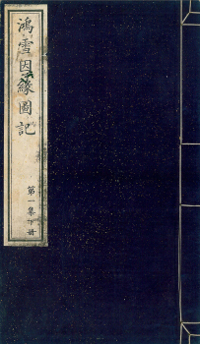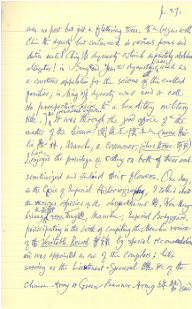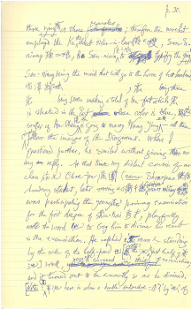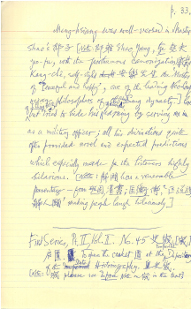|
||||||||||
|
NEW SCHOLARSHIPMengxiang Discoursing on the I Ching 夢薌談易Tracks in the Snow 鴻雪姻緣圖記, Episode 44 by Wanggiyan Lincing 完顏麟慶, translated and annotated by Yang Tsung-han 楊宗翰 Edited by John Minford with Rachel MayThis extract is from the autobiographical memoir Tracks in the Snow (Hongxue yinyuan tuji 鴻雪姻緣圖記), by the Manchu Bannerman author Wanggiyan Lincing 完顏麟慶 (1791-1846), also known as Linqing. It forms part of a research project devoted to the Bannerman culture of the early nineteenth century, under John Minford and Geremie R. Barmé and funded in part by the Australian Research Council. This translation has been edited by John Minford with Rachel May from the original manuscript draft of Professor Yang Tsung-han 楊宗翰 (1901-1992), done while he was an Honorary Fellow at the Research Centre for Translation of the Chinese University of Hong Kong, between 1985 and 1990. We include here reproductions of the manuscript pages from Professor Yang’s draft, as well as the original text by Lincing, with accompanying illustration. For an earlier piece by Lincing in this journal, see Singing with the Spring in Issue 13 (March 2008). Another edited extract from Professor Yang's draft translation of Tracks in the Snow appeared in the March 2009 issue of China Heritage Quarterly under New Scholarship. Prior to this selections from Tracks in the Snow have been published in East Asian History 6 (December 1993), pp.105-142, and in Renditions 51 (Spring 1999), pp.29-65. LC: Lincing YTH: Yang Tsung-han JM: John Minford 
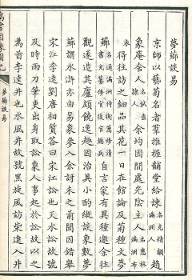 The Chinese text of Lincing's essay 'Mengxiang Discoursing on the I Ching', from his Tracks in the Snow. Click on the images above to see a more detailed reproduction. In the Imperial Capital, it is universally agreed that Wo Futang, the Supervisory Censor, LC: A Manchu, named Kejinga 克精額. and Zhao Xiang'an LC: Prospective heir of a hereditary military title. His name was Shi 鉽, and a native of Zhili 直隸. YTH: Another example of the absurd and exasperating pseudo-literary style whereby an ancient or obsolete official title is used to indicate a modern official post, or just as a flattering term with no actual post. The title sheren 舍人 began with the Qin 秦 dynasty but continued in various forms indicating various duties until the Qing 清 dynasty, when it was definitely abolished altogether! In the Song 宋 and Yuan 元 dynasties it was used as a courteous appellation for the scions of exalted families; in the Ming 明 dynasty it was used to designate the prospective heirs to a hereditary military title. are the true experts among those who devote themselves to the cultivation of chrysanthemums. It was through the good offices of my friend the Master of Leisure LC: A Manchu bondservant named Huilin 惠林. YTH: filius terrae. JM: Yang adds the Latin, to emphasize that he was a person of lowly origin. that I had the privilege of calling on both of them to study and admire their flowers.  Woodblock illustration for 'Mengxiang Discoursing on the I Ching', from Lincing's Tracks in the Snow. One day, in the Office of Imperial Historiography, I was talking about the various species of chrysanthemum, when Wen Mengxiang 文夢薌 LC: A Manchu whose personal name was Tong 通, member of the Imperial Bodyguard, participated in the work of compiling the Manchu version of the Veritable Record 實錄 by special recommendation, and was appointed as one of the official compilers; later serving as Lieutenant-General 總兵 [of the Chinese or Green Banner Army 綠營]. said that in his family garden there were some unusual varieties and invited me to go and see them for myself. I did so, and I found it a most delightful experience. He had sumptuous food and drink prepared and invited me to stay, expatiating all the while on the symbols 象 and numbers 數 of the I Ching. YTH: To divine 卜 by scorching the shell of a tortoise is to get the images 象; to divine 筮 by the stalk of a particular plant is to get the numbers 數: Cf. 物生而後有象…而後有…數 (左傳僖公十五年)—in other words, the essential doctrine and function of I Ching—龜以象示,筮以數告…所以知吉凶。 Mengxiang also said that the novel Water Margin 水滸傳 was based on an exposition of the doctrine of the images in the I Ching. I had never heard of such an interpretation and was greatly surprised. Then I variously mentioned characters in the novel like Song Jiang 宋江, Li Kui 李逵 and Liu Tang 劉唐, asking him to elucidate his theory. He replied: ‘Song Jiang is “Conflict” 訟, Hexagram 6, 天水 Heaven over Water: 天水訟. YTH: 天水 equals 趙, since it is the conventional geographical indication of Zhao 趙, e.g., 天水趙氏. 訟 is a double-entendre, a homophone of Song 宋. Therefore 天水訟 means 趙宋. JM: Zhao was the family name of the emperors of the great Song dynasty (960-1279), as opposed to the Liu family who ruled the earlier Liu/Song dynasty (420-479). Hence his sobriquet “Rain in Season” 及時雨. He is also a clerk of court 刀筆吏 by profession, which gives rise to the image of Conflict. Since human affairs are often generated by conflict, he, Song Jiang, is the main character of the novel. Li Kui is “The Well”, Hexagram 48, Water over Wind. Hence his sobriquet “Black Whirlwind” 黑旋風. In his search for the Squire, Chai Jin, he enters the well; when he goes to meet his mother he enters the well, JM: In Chapter 42 of the seventy-chapter edition of Water Margin, Li Kui fetches water for his mother. 'He soon heard the sound of running water, and after a few turns he came to a small stream. He had a good drink, using his hands as a cup, and then thought: ‘How can I carry some water to my mother?' Jackson, Water Margin, p.603. Chapter 53 is entitled: ‘The Black Whirlwind descends into a well to rescue Chai Jin.’ which gives rise to the image of The Well. Liu Tang is “The Cauldron”, Hexagram 50, Fire over Wind—hence his sobriquet “Red-haired Devil”. He is bound to the altar table, which gives rise to the image of “The Cauldron”.’ JM: Liu Tang is the ‘big man sleeping naked on the altar table’, who is later bound with ropes. (Water Margin, chapters 12 & 13.) I asked further: 'In the novel there are only three female characters. What is the meaning of Hu San-niang's being called “Ten Feet Blue”?’ ‘Well,’ replied he, ‘in a hexagram there are only three yin places; therefore the novelist uses three women—eldest sister-in-law Gu, Sun Er-niang, and Hu San-niang—to represent the yin. San-niang is “The Marrying Maiden”, Hexagram 54, Thunder over Lake. Thunder is three, Lake is seven, making a total of ten (feet). Thunder is situated in the East and its colour is blue. Hu San-niang, the sister of Hu Cheng, is going to marry Wang Ying, which gives rise to the image of the Hexagram.’ When I questioned him further, he smiled without giving me any reply. At that time my distant cousin Zhepu (蔗圃 Cane Garden), LC: His name was Shuangbao 雙保, an Academy Student 生員, later serving as 衛千總 (Garrison minor military officer) was participating in the youngsters’ primary examination 童試 for the first degree of xiucai 秀才. He playfully wrote down the word ta 他 and begged our host Wen Mengxiang to divine his result in the examination. He replied: ‘A man is standing beside half a pond. YTH: 也, the right hand component of ta 他 is also just half (the right hand half) of 池, meaning pond. You will succeed.’ It turned out exactly as he divined. YTH: I: 半池 here is also a double-entendre: 1) 人 beside 也, of course, is the man standing by 也, which represents half of the word pond 池; but, 2) 池 here also refers to the architectural shape (semi-circular) of the Pan Gong 泮宮, or Pan Shui 泮水 —the State Academy in the County and Prefecture; Cf. 詩,頌, 泮水. JM: Yang, while commenting so helpfully on this example of the ancient art of divination by ‘character-dissection’ 拆字, also sends us back to the locus classicus of the expression Pan Shui 泮水 in the Book of Songs, where it is the ‘title’ of Song 299 (Legge’s translation, pp.616ff.). In that early text, the meaning of the character pan itself is thought by some commentators (not all) to derive from its own components (water on the left and half on the right), thus referring to a semi-circular stretch of water on one side of the college. Mengxiang was well-versed in Master Shao's interpretation of the I Ching, YTH: 邵子 is 邵雍 Shao Yong, zi Yaofu 堯夫, posthumously canonized as 康節 Kangjie, self-styled 安樂先生, the ‘Master of Peace and Joy’, one of the leading Neo-Confucian philosophers of the (Zhao) Song dynasty. but hid his illustrious learning by serving as a military officer. All of his divinations came true and he often provided novel readings of ancient texts, which reduced his listeners to fits of hilarious laughter 解頤. YTH: 解頤 has a venerable parentage—from 班固, 漢書, 匡衡傳: ‘匡說詩解人頤’, ‘making people laugh hilariously’. |
